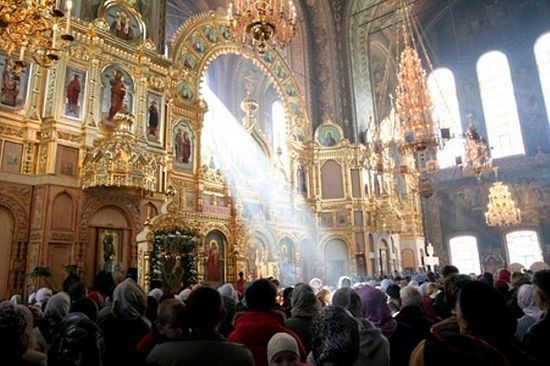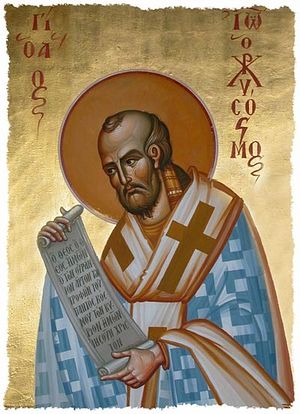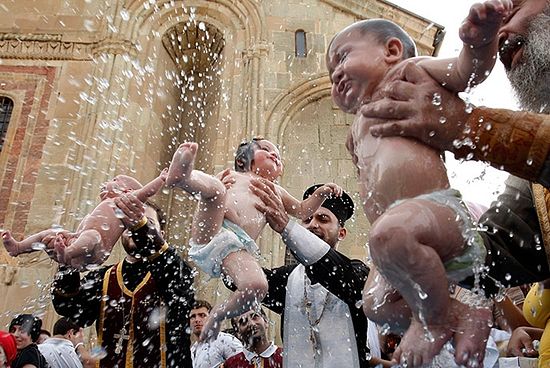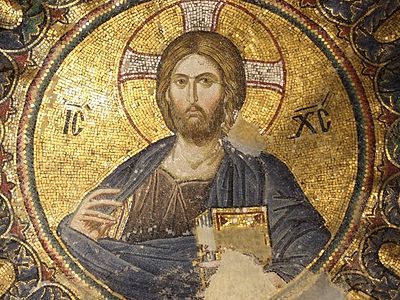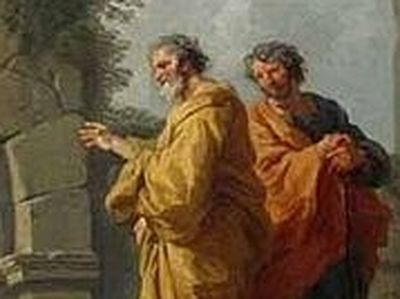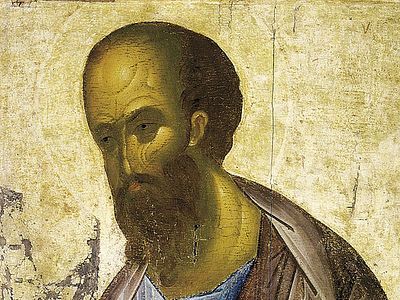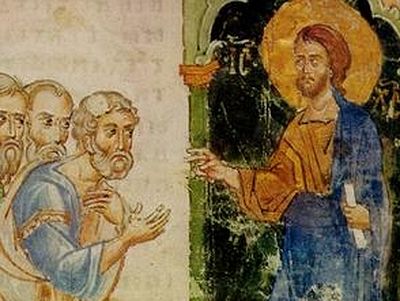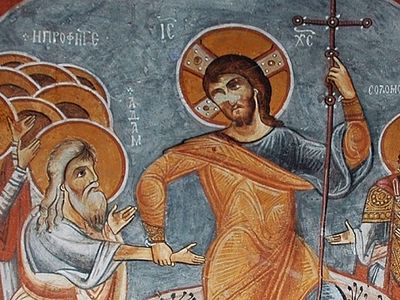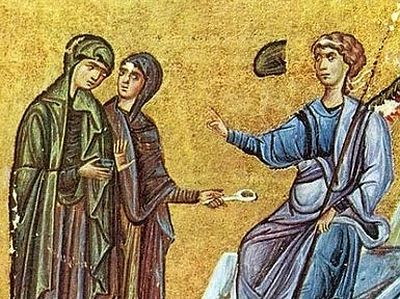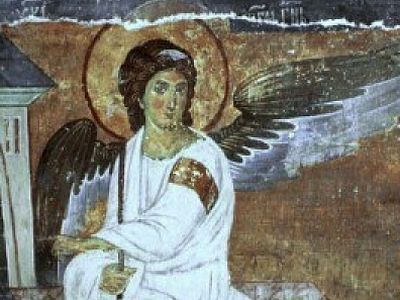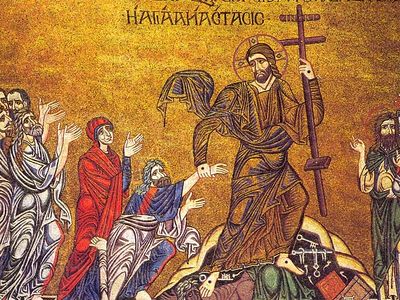See Christ is Risen! Part 7a. Subtle Differences Between East and West
In this final installment of her series on the Resurrection of Christ, Dr. Jeannie Constantinou finishes her discussion of the apostle Paul’s second epistle to the Corinthians on Christ’s resurrection and the general resurrection of the dead.
Christ is Risen from the dead, trampling down death by death, and upon those in the tombs bestowing life.
Christ as the first fruits.
Now continuing our discussion of 1 Corinthians 15, which contains the oldest written account of the Resurrection appearances of Christ, we’re going to touch on a couple more points in this chapter with the continuation of Paul’s statements after he reminds them, the Corinthians, of the Gospel that he preached to them, of the Apostolic testimony about the Resurrection of Christ. We’re going to talk about what he meant by “first fruits”, and also what he meant by the statement “those who are baptized for the dead”—a very enigmatic statement. So, what did he say? At the beginning of the chapter he reminded them of the Gospel, he says, which he preached to them, which they received and in which they stood, and by which, he says, “you are saved, if you hold fast to that word which I preached you.” This shows that salvation requires adherences to correct doctrine. This is what I was saying: doctrine matters. Doctrine is not something we can take or leave, you know, according to our whim.
If there’s something the Church teaches that you don’t understand, if you don’t understand the reason for it or the importance of it, you need to learn more. You just don’t decide on your own, “Oh, I’m just going to forget about this,” “I’m not going to accept this,” “I’m not going to believe this.” You have to understand that there’s a reason for the doctrines. So, Paul said, “by which you are saved.” This is verse 2: “If you hold fast to that word which I preached to you.” So, salvation is dependent upon adherence, continued adherence, to Apostolic Tradition. This is oral tradition, because Paul is telling them something that has never been written down before—in this case the resurrection appearances. So you’re saved if you believe this doctrine. So there’s an adherence to oral apostolic preaching, and Paul emphasizes that this is necessary for salvation. That’s really remarkable. So you see, there’s no hint here of “Sola Scriptura,” there’s no hint here of the “Scriptures Alone” or Faith Alone” or “doctrine alone” or “good deeds alone,” but all of these things together are necessary for salvation. We don’t over-emphasize one, but we also don’t neglect anything, because in some places, yes, Paul emphasizes faith, elsewhere he emphasizes good deeds, elsewhere something else. Here he’s emphasizing that they must hold on to Apostolic oral Tradition, and the doctrine that he’s talking about specifically is not the resurrection of Christ, which these Corinthians accept, but the general resurrection of the dead.
The Corinthians believed in the resurrection of Christ, but some of them did not believe in the general resurrection at the end time. But Paul is not content with the fact that they believe in the Resurrection of Christ. Today many of us would say “Hey, that’s good enough”, that’s the part that’s hard for people to believe today—the Resurrection of Christ—because everyone wants proof. But Paul is not satisfied with the fact that they believe in the resurrection of Christ. He insists that they must accept the totality of the apostolic oral preaching. That’s the Gospel. The Gospel is not just “Jesus saves”, “Christ died” and that’s it. When he says, “I preached to you the Gospel,” as I told you a couple of podcasts ago, the “gospel” consists of about five basic sentences. Part of it is eternal life for us, that demands that we believe that we too can rise because Christ rose. That’s the part that some of the Corinthians would not accept. So Paul wasn’t satisfied if they rejected any part of the doctrine. They had received the entire Tradition and he expected them to hold it fast, as he said, to preserve it, to pass it on. That’s the meaning of the word “tradition”—that you receive something and you hand it over to someone else whole, complete, exactly as you received it.
Akolouthia
I mentioned in the last podcast that Chrysostom spent five sermons to cover this one chapter of 1 Corinthians, and he engaged in a rather complicated analysis of the chapter. I have to say that it was not easy to read these sermons of Chrysostom, because much of what he said was directed at heresies that no longer exist, and ideas in Greek philosophy that dominated the thought processes of people at the time but don’t hold sway anymore. Today we have different ways of conceiving of the world. Today we have different heresies that affect us. But Chrysostom analyzed Paul’s arguments point by point, and I want to show you how he uses a particular technique. One technique he uses here is a type of patristic exegesis or a technique of patristic exegesis, called “sequence.” In Greek the word is “akolouthia,” and I’m pointing this out to you, how he handles the argument, because I want you to understand that the Fathers didn’t understand the Scriptures just because they were holy. They didn’t just pray and ask God to illumine them and say, “I have the Holy Spirit, I know what it means.” No. First of all, before Chrysostom would give a sermon, he prepared for it. There’s a beautiful story about Chrysostom and St. Paul one I’ll share with you, but not now. So he prepared for the sermon. He had already studied this passage with a teacher, most likely, because this was a very important passage. His teacher was a well-known member of the school of Antioch named Diodore of Tarsus, and under Diodore Chrysostom learned this. Furthermore, all of the Fathers knew specific techniques which they use to analyze the Scriptures. It was very scholarly, it was very scientific, it was very academic—not just spiritual, but also academic. They knew what they were doing when they analyzed the Bible. This is the Orthodox Tradition. It’s not enough just to say, “I’ve got the Holy Spirit and I’m going to pray hard enough, and God will illumine me.” Yes, this can happen, there’s no question that their holiness definitely impacted and helped; but they didn’t just rely on that. They studied the Scriptures. They studied them in an academic setting with a teacher, and they learned specific techniques.
I’m telling you this before we begin our introduction to the Bible. We have to learn about the basics of the Bible. The Fathers knew all of these things, so we have to have a certain amount of foundational information before we can proceed. So, we’re going to follow their lead and the opportunity as it comes up when we are discussing a specific passage. I will introduce you to some of these techniques that the Fathers used. Now here we see his application of the technique of sequence, “akolouthia.” Now sequence is very closely related to context, and this is important, because Chrysostom, and all of the Fathers, were very careful not to take statements out from the Bible, out of their context, but to understand the point that the Bible writer is making in context. Otherwise you give it an interpretation contrary to what is intended.
Now context is unfortunately sometimes neglected. First of all, that’s very basic. Any good exegete is going to do that. But today, there are great many people who take the Bible, and they mine it for isolated verses. They want to prove something, so they point to one verse and they literally take it out of context—you know what I’m talking about, right? And so Chrysostom is very careful to understand the train of Paul’s thoughts, the sequence of thought. That is what is meant by “sequence”—how he goes from one point to the next and draws his conclusions.
So listen to Chrysostom’s statements about verse 12, which reads, “Now if Christ be preached that He rose from the dead, how say some among you that there is no resurrection of the dead?” Here’s Chrysostom’s observation: “See how excellently he reasons and proves the Resurrection from the fact of Christ being raised, having first established the former by many ways. For both the prophets spoke of it…” (here Chrysostom is talking about the statement in the early part of the chapter, “according to the Scriptures,” that Christ died and He rose according to the Scriptures) “For both the prophets spoke of it and the Lord Himself showed it by His appearing and we preach and you believed, weaving thus his fourfold testimony: the witness of the prophets, the witness of the issue of the events, the witness of the apostles, the witness of the disciples, or rather a fivefold…” Now here he’s saying “fivefold.”
If Christ rose, how can you say the dead do not rise?
Let me interrupt here, because earlier in the sermon Chrysostom said about the Corinthians that when Paul gave them the tradition, they accepted it. They also became witnesses, and when they decided that they didn’t like the part about the general Resurrection of everyone, they became witnesses against themselves. That’s why he’s saying fivefold, because he just listed only four things, but now he’s talking about fivefold. He’s talking about the fact that the Tradition lives on within the worshipping community, among the community of faith. Continuing now with Chrysostom’s comments, “For this very cause, too, itself implies the Resurrection, his dying for other sins. If therefore this has been proven [he’s talking about Christ’s Resurrection], it is evident that the other also follows—that is, that the other dead likewise are raised, and this is why as concerning an admitted fact he challenges and questions them saying, ‘Now if Christ has been raised, how do some of you say that there is no resurrection of the dead?’” That was from Homily 39.
Here Chrysostom is pointing out Paul’s argument that it is an established fact that Christ is risen. Now it is an obviously established fact, as far as Paul was concerned in those days, because Paul just reminded the Corinthians that most of the eyewitnesses to the Resurrection whom he had listed are still alive! So the Corinthians do not question the fact that Christ rose, but they’re saying, “but that doesn’t mean that we will rise.” So Chrysostom notes Paul’s argument, that if it is an established fact that Christ rose, how can you say that the dead do not rise? Today it’s harder to make that argument because people don’t accept the idea that Christ rose—certainly non-believers don’t. And some people who consider themselves Christians do not believe that Christ rose. But you see there’s a very important point to be made here, something very important to notice. How can you say that the dead do not rise if Christ rose? Now what you’re saying of course is that, in a way, to deny the general Resurrection is to deny the humanity of Christ, because he’s saying that, “If Christ rose, how can you say the dead do not rise?” This has to do with the fact that they thought that the dead couldn’t rise or wouldn’t rise. As I mentioned this to you before, this is because in Greek philosophy, it was thought to be rather useless for the soul to return to the body. They didn’t think that that was a good thing, because the body was a prison for the soul, and it wouldn’t be positive thing for the body to rise.
But they also had other beliefs that made it impossible for the body to rise because Greek philosophy, which was again the dominant mode of thinking at the time, taught that all of creation, the whole created world, was composed of four basic elements: earth, fire, air and water. Your body was supposedly also composed of a combination of these different things, and when you died, when the body dissolved, all of the basic elements that composed the body returned to their natural state. They believed it was basically impossible for the body to be reconstituted. That was their concept of science at the time. That’s why they said the resurrection of the dead is impossible. But, of course, if you’re saying that Christ could rise but we wouldn’t rise, you are saying that Christ didn’t share our humanity. Do you see the point there? It’s extremely important to affirm the humanity of Christ as well as His divinity. And for them that was a bit of a problem, because now they’re denying that Christ’s humanity is the same as ours, that Christ is homoousious, one in essence with us in our humanity. Because if the dead don’t rise, if humans don’t rise, then Christ also didn’t rise; or if He did rise, He wasn’t human the way we are. So there is an important theological point to be made there.
Chrysostom would have been making this point if he were preaching after the heresy of Nestorianism, and after some other heresies. But he does emphasize the real humanity of Christ, because this was still an issue among many people during his time. At that time, the Church was still fighting the heresy of Docetism, which appeared very strongly in the end of the first century to the beginning of the second century. Docetism was the teaching that Jesus was not really human. He wasn’t really incarnate with an actual body. He just seemed to be human. This belief formed parts of other heresies, such as Manicheanism and Gnosticism, and this is why Chrysostom is fighting it along with Greek philosophy at practically every turn throughout these five sermons.
The heresies of Chrysostom’s time.
Now Chrysostom, of course, is responding to the heresies and the fallacies held by the people at that time; these heresies were still around at the time of Chrysostom because his congregation was still very dominated by concepts from Greek philosophy. But these beliefs are not held today, and unfortunately sometimes we wish the Fathers would address certain issues that are facing our world today. When it comes to moral questions, questions of people’s behavior, the Fathers are absolutely current and what they say is really timeless. But in many of their arguments against certain beliefs they’re citing and they’re responding to the heresies of their time. So we have to find a way to take what they teach us and to apply them to the issues facing our times. So here’s one way that we can do this in this particular instance of Chrysostom commenting on St. Paul’s statements in 1 Corinthians 15. Chrysostom makes a point that he doesn’t elaborate on, but I think it’s very appropriate for us today. He makes a point that to deny the Resurrection is to basically ascribe sin to Christ. He doesn’t elaborate on this, because he turns his attention to the arguments that would most fit his attacks on these other types of heresies which were rampant still, or at least present still, at the time that he was preaching.
So first of all, before I explain what he means by this, I want you to understand that it is important for us to understand the Bible in its historical context, but likewise the Church Fathers. If you don’t know Church history, if you don’t know theology, if you don’t know the heresies, very often what a particular patristic writer is saying will go over your head or you will entirely misunderstand him, because these writers were arguing against the heresies of their times. We have different heresies that we need to respond to in our times.
Congregations that were listening to the Fathers, Chrysostom’s congregation, understood perfectly what he was talking about. But if we don’t know Church history, then we don’t understand it. I will give you a very quick example. When we were talking about the Crucifixion and I quoted to you one of Chrysostom’s statements commenting on Christ’s statement from the Cross, “My God, my God, why have you forsaken me?” I quoted him saying that Christ “to his last hour bore witness to the Old Testament.” After I read that to you, I wondered how many people understood what Chrysostom was talking about. Why did Chrysostom say that Christ from the Cross “bore witness to the Old Testament”? What’s the point of that? Well, because Chrysostom was making a point, an argument against another heresy of his time, which was the heresy of Marcion. Marcion taught that Christians should reject the Old Testament and all of the Jewish heritage of the Church, because the God of the Old Testament is not the same God as the New Testament. So Chrysostom’s congregation knew exactly what he was talking about. I don’t know how many of you understood that comment, but this is an example of what I was trying to tell you. If you don’t know who Marcion was or what his heresy consisted of, if you don’t know what was going on in the Church at the time, you are not going to understand the points that the Fathers are making; in fact, you might misunderstand them. So we have to learn about all of these things, brothers and sisters. I’m not trying to make you anxious that you need to know everything at once; this is a slow process, our process of learning. But I want you to be aware that you have to read these things with a certain amount of knowledge to understand them correctly—you shouldn’t try to understand everything in isolation, but talk to your priest and ask him to help you understand the things that you don’t understand. So, we need to know the historical context of the Fathers as well.
Let’s talk about what Chrysostom said—the point he made that I think is very valuable for us today, about the Resurrection of Christ. Chrysostom does not elaborate on the connection between the sinlessness of Christ and the Resurrection, but you can understand this connection, and if you do, you will understand his theological point. So what I’m going to tell is you is not exactly the words of Chrysostom, but what he’s hinting at. Here it is. Christ died for our sins. All Christians accept that. There are some Christians who don’t believe in the Resurrection, but they believe that Christ died for our sins; otherwise I don’t know why they would be Christians. So we’re talking against people who don’t believe that Christ rose from the dead. If you say that Christ died for our sins, this means He had to be sinless in order to die for our sins, right? Otherwise He would have died for His own sins. Let me say that again. Christ died for our sins, which means he had to be sinless to die for our sins; otherwise He would have died for His own sins, because death is the consequence of sin. So, we believe that Christ rose from the dead, that He conquered death because He was sinless. Christ was sinless, that’s why He rose in the body. If you say that Christ did not rise, you are saying that Christ had sins, in which case He didn’t save us, in which case He’s not the Savior, He’s not the Lord, He’s not anything. He’s just another human being. So to deny the Resurrection of Christ is to deny the basics of Christian doctrine, that Christ was sinless, that He’s the Savior—all of these things, the Christian faith in its entirety.
So, you see that all of these things hang together, and that’s why we can’t pick and choose what we want to believe. When you reject one tenet of the faith, it affects other things as well. The Fathers knew this very well—that’s why they were very careful, very zealous to guard our theological doctrines very, very precisely and to formulate them with extreme precision. When it comes to theology we must be very precise. And if we don’t know our theology well, it’s better to be silent; it’s better not to say anything. I think I hinted about this last time, but this comes from St. Gregory the Theologian, Oration 32. It’s a remarkable oration where he talks about the importance of precision in theology and how important it is that we should try to refrain from talking about God unless it’s absolutely necessary. And then we should only do so if we are well trained and extremely knowledgeable about these things. It’s not something to be played with or toyed with. So, this is the point—and I think it’s a good point—that Chrysostom hinted at about the connection between Christ’s sinlessness and the Resurrection.
Our sins are loosed.
Verse 13 and 14, St. Paul: “But if there is no resurrection of the dead, then Christ is not risen, and if Christ is not risen, then our preaching is empty and your faith is also empty.” To this Chrysostom says, “If after death He could not rise again, neither is sin loosed nor death taken away, nor the curse removed, and not only have we preached in vain but you have also believed in vain. And not hereby alone does he show them the piety of these evil doctrines, but he further contends earnestly against them saying…” and then he quotes verse 15. But notice how Chrysostom is making the connection between sin being loosed and Christ’s sinlessness, and its effect on us. But notice how he’s now connecting those verses with verse 15. Here’s verse 15: “And we are found false witnesses of God because we have testified of God that He raised up Christ whom He did not raise up if in fact the dead do not rise.” So Paul is saying here, basically, that the apostles are liars if you say that the dead don’t rise, because if the dead don’t rise, then Christ didn’t rise either, because Christ died and Christ had a body just like us, and you’re saying that we are false witnesses—that’s what Paul is accusing them of. And Chrysostom points out also the great sacrifices which were made by the apostles, which Paul also mentions very briefly in this chapter, the perils that they encountered; how Paul says, “We die daily.” Chrysostom says that this means that they were in constant danger—obviously they couldn’t die every day. It means that they were in constant danger, that they were prepared to face death every single day. And this is exactly what I was telling you about in the first podcast on this series on the Resurrection, about the importance of the apostolic witness and how impossible it was that a large number of people would have fabricated the story of Christ’s bodily resurrection— because they had nothing to gain by it. This is what Paul said, and Chrysostom notes also the dangers that Paul and the other apostles faced with absolutely no reward in this life. If there was no resurrection then there was no reward at all. If there was just this life, and they were totally fabricating this and were false witnesses as Paul puts it, then they’re the losers. Paul says they have nothing to gain by this, and if the dead are not raised, “Let us eat and drink for tomorrow we die”—meaning if all we have is this life we might as well enjoy it; if the dead are not raised, that means that Christ did not rise and we are really wasting our time and our faith is in vain.
If the dead do not rise, we are still in our sins.
Let’s continue with verses 16 and 17: “For if the dead do not rise then Christ is not risen, and if Christ is not risen your faith is futile and you are still in your sins.” What about that? What about that? You’re still in your sins. He didn’t say, if Christ has not died you’re still in your sins, but if Christ is not risen you’re still in your sins. This is what I was trying to tell you—that the death of Christ has to do with the Resurrection, and the atonement of Christ is not about satisfaction and payment, some kind of payment that God demands because there was a “crime” and there has to be some kind of punishment for it. But there’s a connection to the Resurrection, because if Christ is not risen you’re still in your sins, because the death of Christ is about the conquering of sin, the conquering of death, which was the penalty of sin— do you see? Not because it was demanded by God. The satisfaction theory of atonement is not present here anywhere that I can see. Now the ultimate point is the same. We can make the same argument from the reverse or the converse. Notice that here the Resurrection is an absolute requirement for the forgiveness of sins, as we have been saying. Now in verses 18 and 19 he says, “Then also those who have fallen asleep in Christ have perished, if in this life only we have hope in Christ, we are of all men the most pitiable.” Why are they the most pitiable? Because without belief in the resurrection we are wasting our time being Christians. We believe in nothing. It’s the foundation of our faith. I think you understand his point there—he’s repeated it quite a few times.
The first fruits.
He mentions the image of the “first fruits” in verse 20: “But now Christ is risen from the dead and has become the first fruits of those who have fallen asleep.” This is a really beautiful image—the first fruits. I don’t know if we can appreciate it because we don’t live in an agrarian society, but they understood very well what Paul was talking about, because the “first fruits” concept explains the connection between Christ’s death and resurrection and our death and resurrection. Again, he’s trying to convince them that they too will rise. This is Paul now trying to convince the Corinthians who don’t believe in the general resurrection. Here is what it means. A tree never bears just one fruit. There may be a fruitless tree, fine; then there will be no fruit, but there’s no such thing as a tree that bears just one fruit. There is initially one fruit that appears, but it is followed by many, many other fruits—a great harvest. So the “first fruit” is a promise and an indication of what we know is to come, because we see that first fruit. So that’s what Christ’s resurrection means to us. Isn’t it a beautiful image? Christ is the only one who rose, but we believe that we too will rise because we have seen His resurrection. We know it happened and so we have confidence in our resurrection as well.
“Baptism for the dead”?
Now let’s talk about this puzzling verse, this thing that has confused interpreters for a long time, and they have debated it for a long time. It’s this reference to the “baptism for the dead.” Now, many of you know of this verse, or if you went ahead and read through perhaps you noticed this particular verse. Here’s the verse—verse 29: “Otherwise what will they do who are baptized for the dead, if the dead do not rise at all? Why then are they baptized for the dead?” Now, I try my very best to give you good information on this program, so one of the things I did was ask one of the professors at the University of San Diego who is a Pauline expert, if there’s anything new to be said about this verse. And she told me as a matter of fact she went through an entire seminar recently that was just about this one verse, and there was really nothing new that had been said, or at least there was nothing definitive. In other words, scholars have not come to any kind of consensus about what this verse means. Some believe that there was a practice in the early Church to baptize people in the name of the dead and to try to save them. Of course, I don’t think this would have been a practice in the early Church, because there is no such thing as salvation by proxy. We know what the early Church tradition is for those who died before Christ: It was that He went to Hades and preached to the dead, and gave them the opportunity to accept or reject the salvation that was offered. So, I don’t think that that holds water, even though is seems to be what Paul is saying, because there’s no such thing as salvation by proxy.
Now, with baptism of infants you can’t make that argument—that this is what it is—because they also baptize infants who don’t answer for themselves. A child grows up and affirms or rejects his own baptism, so that’s not what’s going on here. This is a very vague statement and it’s very difficult to know if anyone actually practiced such a thing as what Paul is referring to, but it does not seem to be apostolic. I am telling you this because if it were apostolic we would be doing it today and/or we would find this kind of a thing mentioned in some other early Christian literature. But the idea of baptizing someone in the name of a dead person doesn’t appear anywhere else in any other early Christian literature. That’s why it’s so enigmatic, and we’re really not sure what Paul meant by it. But that’s why I don’t think it was a practice in the early Church.
Now I’ll tell you about something else. You can find writings, and you can find statements, about practices that were done among some people who called themselves Christians during the early centuries of the Church, but that doesn’t mean that what they were teaching or doing was apostolic Christianity, because there were all kinds of heresies. There were heresies that had all kinds of weird practices. This doesn’t mean that this was authentic, early Christianity. Just because you find something being done by somebody in an early century doesn’t mean it’s correct, because there were many heresies and heretics, and some of them had some very bizarre practices. Just because something is ancient doesn’t mean it’s correct, so you have to be careful about this. Now a footnote in the Orthodox Study Bible says Chrysostom considered this statement about the baptism of the dead a derisive comment about the practices of the Marcionite heretics—those would be the followers of Marcion that I spoke about earlier. Marcion taught that the Old Testament and everything that had to do with Judaism should be removed from the Church and completely rejected. That footnote is not exactly correct. It’s at the very least misleading. Here’s why. Chrysostom did not consider this a derisive comment about the practices of Marcion because Paul lived a hundred years before Marcion. So Paul was not talking about Marcionite practices, because it took a hundred years for that heresy to come about, and Chrysostom knew that very well. It is true that Chrysostom uses this verse to attack the practices of the Marcionites, in true Chrysostom fashion, but he doesn’t consider this verse to be a comment that Paul made about the practices of the Marcionites. Do you see the difference?
So what does Chrysostom say about the meaning of this verse? Incidentally, I hope you don’t get upset that I said something critical of the Orthodox Study Bible. I just want you to be aware that not everything we read in books, including the notes of the Orthodox Study Bible, are necessarily correct. The notes are not Scripture. The notes are not inspired. The notes are someone’s opinion or a committee’s opinion. They’re not the last word about any given passage, and I am also not the last word about any passage. I’m not trying to pretend that I know everything or everything I say is absolutely correct, I’m just doing the best I can. But I’m pointing this out to you because I want you to understand that we need to do our own studies sometimes, we need to use our own minds, and that when it comes to the Fathers, very often people are quite sloppy and superficial in their studying. We need to study things well, we need to understand them well, not superficially; and unfortunately, I’m saying this because I’ve seen it a lot. I’ve seen a lot of people misrepresent what the Fathers say.
Here the first thing Chrysostom mentions to his congregation in connection with the baptism of the dead is the Marcionite heresy, because his congregation knew about the Marcionites, they were still around, but that’s not what Chrysostom believes Paul is talking about. So that could be why that ended up in the Orthodox Study Bible, because that’s the first thing he talks about; but that’s not what he says Paul is talking about. In order to know what Paul is talking about, you have to read a little bit further into Chrysostom’s sermon and dig a little bit deeper. And if you doubt what I’m saying you can look up Chrysostom’s interpretation of this particular verse in Homily 40, section 2. As a matter of fact, it’s a little bit difficult to understand what Chrysostom has to say here, because he hesitates to explain this verse due to the presence of the “uninitiated,” that is, the catechumens or others unbaptized who were present. You know that a catechumen is someone who is learning about the Christian faith but is not yet baptized. So we see here that Chrysostom is preaching after the Scripture readings and before the prayers dismissing the catechumens. The catechumens were not permitted to witness the Divine Liturgy, and Chrysostom wants to explain what the verse means, but he does not want to give away the mysteries of the faithful to the catechumens who are not allowed to know the mysteries of the faith, including the Creed. So listen to these statements of Chrysostom and I will explain it as we go along.
Remember that he is explaining Paul’s statement, “What about those who are baptized for the dead?” “But first I wish to remind you who are initiated of the response on that evening they who introduce you to the mysteries bid you to make, and then I will also explain the saying of Paul, so this likewise will be clearer to you, we after all the other things adding this which Paul now says. And I desire indeed expressly to utter it, but I dare not on account of the uninitiated. For these add a difficulty to our exposition, compelling us either not to speak clearly or to declare unto them the ineffable mysteries.” (And “the mysteries” he’s talking about here is the Creed, the Nicene Creed.) “Nevertheless, as I may be able, I will speak as through a veil, as thus: After annunciation of those mystical and fearful words, the awful rules of the doctrine which have come down from Heaven.” (Again, this is a reference to the Creed.) “This also we add at the end when we are about to baptize, bidding them say, ‘I believe in the Resurrection of the dead’, and upon this faith we are baptized. For after we have confessed this together with the rest, then at last we are let down into the fountain of those sacred streams. (The baptismal font.) This therefore Paul is recalling to their minds and said, ‘If there is no Resurrection, why are you then baptized for the dead?’ That is, the dead bodies. For in fact, with a view to this you are baptized, the Resurrection of your dead body, believing that it no longer remains dead and you indeed in the words you make mention of a Resurrection of the dead.” (That’s in the Creed.) “But the priest as in a kind of image signifies to you by the very deed the things which you have believed and confessed in words. When without a sign you believe”—that is, you have said the Creed – “then he gives you the sign also.” That is the immersion. “When thou hast done thine own part, then also God fully assures you how and in what manner by the water for the being baptized and immersed, and the emerging is a symbol of the descent into Hades and the return therefrom. Wherefore also Paul calls baptism a burial, saying, ‘Therefore we are buried with Him by baptism into death’ (Romans 6:4). By this he makes that also which is to come credible, I mean, the resurrection of our bodies.”
Now that’s a lot to absorb, I know, and it is rather complicated. But just see how Chrysostom is connecting this passage in 1 Corinthians to the Creed, which ends with the statement, “And I acknowledge one baptism for the remission of sins, I await the Resurrection of the dead and the life of the age to come. Amen.” He’s connecting also the two parts of that final statement of the Creed: baptism for the remission of sins and the Resurrection of the dead. This is what he’s hinting at and doesn’t want to say out loud because of the catechumens present when he’s speaking. They have never heard the Creed and they will not hear it until the night they are baptized. He connects this to Paul’s comment about the meaning of baptism in Romans 6, and so he’s telling you that Paul’s reference to being baptized for the dead refers to ourselves being baptized for our dead bodies, because baptism means the death of ourselves, the dying and the rising with Christ. This is a very interesting connection, and it is pretty complicated even without Chrysostom tip-toeing around the meaning due to the presence of the catechumens.
With what kind of body are the dead raised?
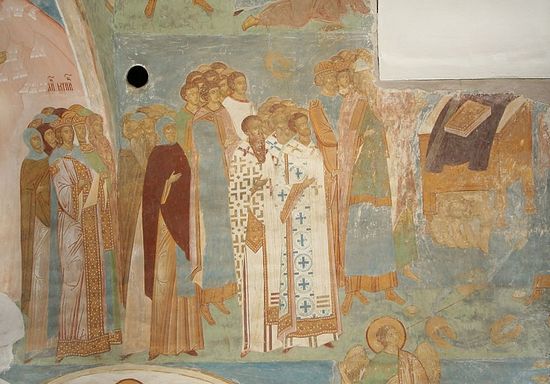 Dionysius. Entrance of the righteous into Paradise. The Dread Judgment. Cathedral of the Nativity of the Theotokos. Photo: dionisy.com
Dionysius. Entrance of the righteous into Paradise. The Dread Judgment. Cathedral of the Nativity of the Theotokos. Photo: dionisy.com In verses 35-58 Paul answers the objections from Greek philosophy—I told you how the Greeks believed that the universe was composed of these four elements and that basically the reconstruction of the body or the recomposition of the body was impossible, as far as they were concerned. This is what Paul was talking about when he’s answering their objections, when they’re saying basically, “How are the dead raised? With what kind of body?” and Paul says it’s a spiritual body. Just as a seed bears no resemblance to the plant or the tree that grows from it, yet it is the same nonetheless. It is just the same with our resurrected bodies, which may bear no resemblance to our bodies now, but they will still be bodies, and they will be our bodies. We would say we the seed has the same DNA as the plant, so there’s no resemblance, but it’s the same. So just as we resemble Adam with his body, the way Adam was constructed by God—arms, legs, head, and a body, etc.—we will also resemble Christ in His final resurrected body. But our body today is like a seed; it bears no resemblance to the final product after the seed is planted. And you know that comparing the body to a seed comes from Christ, who compared the body to a grain of wheat, which if it is not buried remains a single grain, but if it is buried produces a harvest of many grains, right? And that’s from the Gospel of John. That’s why we eat boiled grains of wheat at the memorial services. They are a remembrance and a promise of the Resurrection.
Then Paul says in verse 51: “I tell you a mystery: we will not all die, but we will all be changed in a moment in the twinkling of an eye.” It’s a beautiful verse. And he’s saying here that not everyone will die before Christ returns, and those who are alive will also have to be transformed, just as the dead will be transformed in their new resurrected bodies because, “Flesh and blood cannot inherit the Kingdom of God, nor does corruption inherit incorruption.” Chrysostom says that this is not an argument against the Resurrection just because it says, “Flesh and blood cannot inherit the Kingdom of God.” Paul is not saying that there is no resurrection of the body, but that this physical body will be transformed from what is corrupt into what is incorrupt; from what is mortal to what immortal, the immortal body. Isn’t that beautiful? Well, there’s so much more that can be said about this, dear brothers and sisters, but we have to stop at this point and end our discussion on the Resurrection.
But now, let’s say our prayer one more time: “Christ is risen from the dead, trampling down death by death and upon those in the tombs bestowing life.” Alithos Anesti O Kyrios! Truly the Lord is Risen!
We hope you have benefitted from these podcasts on the Resurrection. The entire Bible studies series of podcasts called “Search the Scriptures” by Presbytera and Dr. Jeannie Constantinou can be found on Ancient Faith.
